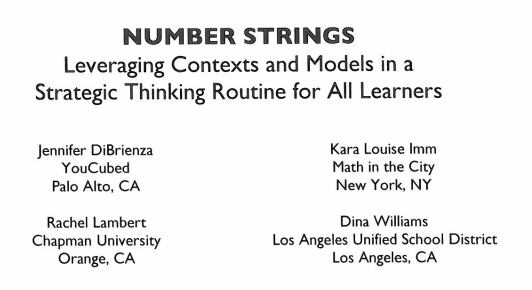What’s the difference between a Number String and a Number Talk?
Last month, a group of experienced number string facilitators (Kara Imm, Jennifer DiBrienza, and Dina Williams) and I presented a session on number strings at the National Council of Supervisors of Mathematics, a conference that runs basically concurrent to NCTM but is oriented for math coaches and administrators.
The session was called Number strings: Leveraging contexts and models, and we chose that title very intentionally. This tweet by Tracy Johnston Zager (@TracyZager) summed it all up:
We hope this slide made the similarities and differences between number strings and number talks as clear as possible. We want to communicate first how powerful both routines are. They draw on the same critical teacher practices: facilitating discussion and representing student strategies. But we also want to make the differences clear, so that teachers can see that the two routines are different, particularly in the sequence of problems and the use of models.
1. Sequence versus a single problem:
You could do a number talk about a single problem such as 18 x 23, paying careful attention to representing multiple student strategies.
Now think about some number strings that might end in 18 x 23. One might be designed to help kids explore the distributive property with the open array
18 x 2
18 x 20
18 x 22
18 x 23
or doubling and the distributive property with a ratio table
2 x 23
4 x 23
8 x 23
10 x 23
18 x 23
Or others (ideas?) Either way, the number string is more like taking a walk on a really nice pathway. You are allowed to wander where you wish, but that pathway is just made so appealing, many kids tend to explore in that direction. Number talks don’t present a pathway, but are more like standing in the middle of a pretty field with multiple avenues to explore.
2. Models
In a number talk, you would use a model only if a student used it as a strategy. However, in a number string you would use a model even if a student doesn’t propose it, if you designed the string around that model. Number strings are almost always designed with a particular model in mind. In my experience, using a model such as an array for the number strings above supports children’s thinking in deep, powerful ways, as every model holds within it mathematical structure. I believe that kids thinking becomes more complex when supported by models, particularly mental calculation.
So while those are the general differences, there is a lot of overlap. In Sherry Parrish’s book Number Talks, she proposes a hybrid between the two routines. She presents series of problems, and encourages the use of models. Teachers who are familiar with both routines can move back and forth between them, some days deeply delving into a few problems from multiple perspectives, other days following the carefully designed sequence of a number string. Number strings are particularly good at encouraging children to try new strategies.
I am particularly interested in the relationship between the last problem in a number string, sometimes called the challenge problem (or “clunker” problem as Jennifer DiBrienza calls it) and a number talk. Experienced number strings teachers sometimes just present a challenge problem (like 18 x 23) and ask students to write their own number string for it. This can allow a deeper look into a single complex problem, otherwise known as a number talk!


Thank you for sharing this post. As an Instructional Leader in my board I often get asked this question by the teachers I work with. Many are using the Sherri Parish book Number Talks and are loving it. We are seeing amazing gains in our students number sense and flexibility. We also had Cathy Fosnot present at our board a few years ago so I also have teachers doing number strings. When I get asked I always answer similar to what you have said, “That they are both quality routines”. I like how you have described it here with your explanation. I am going to share this link onto my schools conferences, if you don’t mind. I like both methods and think using both is a good idea, Thank you for the post.